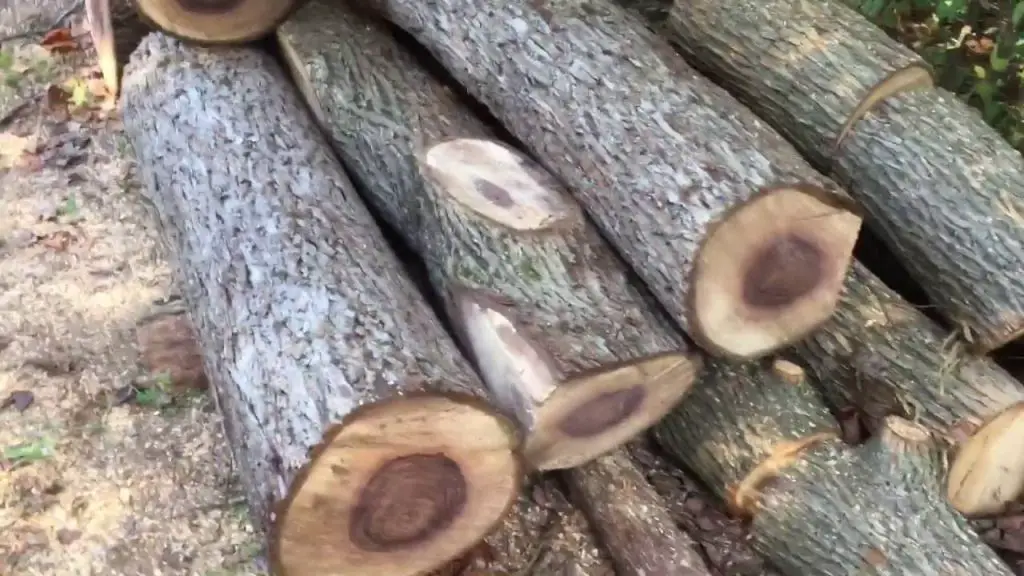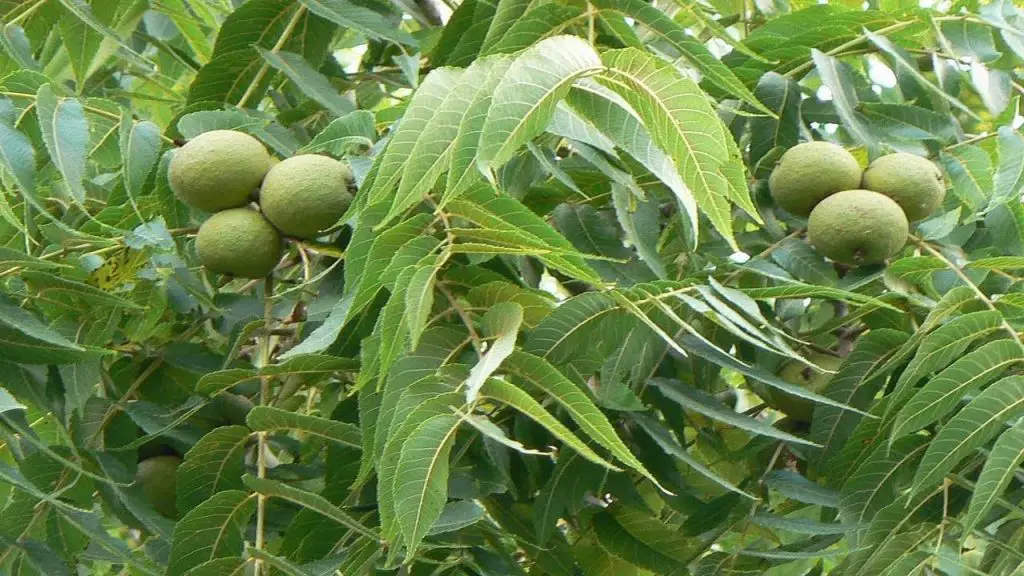Black Walnut is excellent firewood with reasonable heat production, fast seasoning time, is easy to split, and smells great.
Most wood from walnut trees is processed into fine furniture and is in demand and costly.
Walnut trees also have delicious nuts that are a staple in American cuisine and contain the highest protein of any other tree nut. People can also make natural dyes from walnut husks.
Talk about versatility; you can use walnut wood as firewood that dries quickly and is easy to burn. Because of this, black walnut firewood has become a favorite of some people.
Table of Contents
Summary
- BTU: 22.2 million
- Weight: 3,192 lbs per dry cord
- Seasoning Time: 6 months – 2 years
- Splitting: Easy
- Smoke: Low
- Smell: Good
Walnut trees are a hardwood that has many different types of species. Depending on the species, walnut trees will grow to be 30-130 feet tall. The leaves are feather-shaped and smooth. The bark of walnut trees depends on the species and varies greatly.
However, the fruit of a walnut tree is very familiar. Walnut trees produce a round hard-shelled fruit. Inside is the food we know as walnuts. Walnuts are often eaten raw, candied, roasted, pickled, or in desserts.

Heat Production
The BTU for black walnut is not as high as other popular hardwoods such as oak. This being said, black walnut firewood does produce a high heat output at 22.2 million BTUs. This is much higher than other firewood like pine or alder.
Dry walnut starts quickly, burns hot, and produces good coals.
A cord of walnut produces the same amount of heat as
- 20,347 cubic feet of natural gas
- 231 gallons of propane
- 152 gallons of heating oil
- 6,184 kilowatt-hours of energy
Smoke Production
Walnut trees do not produce much smoke when seasoned properly.
If you try burning walnut firewood without seasoning it, it will billow dense smoke. Never try burning green walnut inside the house.
Black walnut firewood also produces a low amount of sparks while burning. This is ideal for burning in a fireplace or woodstove.
One of the favorite reasons for burning walnut firewood is because of how clean it will burn when adequately seasoned. However, walnut does burn faster than other hardwoods compared to oak – it is best if you can mix your walnut firewood with oak to get an optimal fire going.
Seasoning Time
Depending on where you live, walnut firewood will need a minimum of 1 year to season. More likely, the wood will need 1.5-2 years to season.
Seasoned wood has a moisture content of less than 20 percent. Firewood with a higher moisture content than 20 percent is harder to light and frustrating to burn. It also produces more smoke and creosotes buildup.
Properly seasoned wood will have cracks and will be light in weight for its size.
One of the biggest complaints about using black walnut as firewood is how long it needs to season. Waiting two years for wood to season can be tedious and challenging to plan around.
I personally recommend this General Tools Moisture Meter. It allows you to accurately gauge how wet your firewood is and whether it is sufficiently seasoned. Over time you can also see how quickly the moisture is dropping and how much longer you need to keep your firewood dropping until it is seasoned and ready to burn.
Press the sharp pins into the wood and you will quickly see the readout show the moisture ranging from 5% to 50%. It also has a Low/Mid/High indication depending on whether the wood is dry enough, so you don’t need to remember the actual values.

Burning Smell
Walnut has a wonderful aroma that many enjoy.
Black walnut has a nutty smell with a slightly earthy undertone. The nuttiness is often called sweet-smelling.
Creosote Buildup
Creosote is a dark brown tar deposited from wood smoke that can build up on the insides of your chimney walls. It contains tiny unburned particles of wood and sap found in smoke. Creosote can be extremely dangerous because of how flammable creosote is and will quickly start a chimney fire.
Black walnut produces a low quantity of creosote when properly seasoned.
Splitting
Walnut firewood is difficult to split when the wood is still green.
After letting the wood dry, walnut will be easy to split with either an axe or an electric wood splitter.
Split walnut has a distinctive appearance to it. You will see older growth in the center of the tree has a reddish-purple hue to it. The newer growth will be blond in color and can be wide or thin.
Walnut has a medium-density grain and is often forked and knotty. Walnut trees grown in densely populated woods will have a straighter grain and, therefore, be easier to cut. Trees planted as landscaping or in yards will be harder to cut. This is because trees that grow from a stand of trees will grow straight and tall. In comparison, a yard tree will produce a large canopy and have more branches.
Different Types/Species
There are three types of walnut trees grown and harvested in the United States. However, there are 20 different kinds of walnut trees overall.
The three most commonly found are;
Black Walnut
- Because of its desirable lumber, the black walnut has become scarce in the wild
- The nuts from the black walnut tree, while tasty, are extremely difficult to process. One needs the force of a rolling car to crack the shells of these nuts open.
- The nuts of the black walnut tree have the highest protein content of any nut tree.
- Black walnut trees produce a toxic chemical that keeps other plants away from them. You will see a 50-80 ft radius around the tree where other plants do not grow.
- Black Walnuts are the only all-wild nut tree in the U.S.
- Wild Black Walnuts are hand-harvested every fall
You can find black walnut trees throughout eastern North America in USDA zones 4-9. They prefer full sun and rich, dark soil to grow. You may hear black walnut trees called American Walnut. They grow up to 150 ft tall and can live for 200 years. The walnut seed is green and then, after falling, will turn a dark brown or black color. The bark of the black walnut tree is dark gray to brown with deep ridges.
Butternut/White Walnut
- White walnut trees grow on stream banks and in areas with well-drained soil.
- White walnut trees are shorter-lived than black walnut and live only until 75 years.
- The wood is extremely valuable and is softer than black walnut
- The wood is also rot-resistant
- Popular for woodworking because of its coarse grain.
The bark of the butternut walnut trees is smooth and gray when young and gray and fissured when mature. They will grow to 66 ft and resemble the black walnut tree, just smaller with smooth bark. However, another distinction is that butternut walnuts grow in an oval shape instead of round. While they emit the same toxic chemicals as black walnut trees, they are not as effective at it, and you will see more shrubbery around the base of a butternut walnut than black walnut.
English Walnut
- Native to Iran, the English walnut tree came to the Americas with English settlers
- The walnuts you see at the store commonly come from English Walnut trees grown in California
- The tree grows rapidly and reaches heights of 40-60 ft.
- The English walnut lives the shortest at 60 years of the three species.
The English walnut tree has smooth olive-colored bark when young and becomes fissured and gray as it matures, similar to the butternut walnut. You may also hear the English walnut tree referred to as Persian walnut, Madeira walnut, or Carpathian walnut. Just like black walnut trees, English walnut fruits will grow bright green on the tree and then darken to almost black after falling.
Other species worth mentioning:
- California Black Walnut
- Arizona Black Walnut
- Andean Walnut
- Japanese Walnut
- Little Walnut
- Manchurian Walnut
Walnut trees that are considered ‘urban walnuts’ are trees that have grown where there are fewer trees around. Urban walnuts will grow out with lots of branches instead of growing vertically. Urban walnut trees are more often cut down and used for firewood. A walnut tree grown in a dense forest is more valuable for its lumber because it will have fewer knots.
As mentioned above, identifying a walnut tree varies from species to species. The bark of a walnut tree will have deep ridges running up and down the trunk, creating diamond-shaped patterns. The bark will be brown or dark gray, or somewhere in between, depending on the species.
All walnut tree leaves are very similar in that they grow in pairs at the end of the twig. The leaves are feather-shaped and are compound. Honeylocust trees and walnut trees have remarkably similar leaves. All walnut trees will turn brown or yellow in the fall.
Walnut tree nuts are extremely distinguishing. They have a hard brown or green shell that surrounds the nut. The shells range in size but are always distinctive.

Comparison to Other Woods
Here, I’ve taken some of the most popular firewoods to burn indoors and compared them to Alder firewood using Utah State University’s findings on Wood Heating
| Firewood | BTUs | Ease of Splitting | Coals | Overall Quality |
| Green Ash | 20.0 | Easy | Good | Excellent |
| Maple | 25.5 | Easy | Excellent | Excellent |
| Bur Oak | 26.2 | Easy | Good | Excellent |
| Black Walnut | 22.2 | Easy | Good | Excellent |
In comparison to other hardwoods, black walnut falls under a medium BTU range along with Birch, Elm, and Cherry woods. However, because it excels in all other categories, black walnut is favored when available in the area.
Frequently Asked Questions
Can you burn black walnut in a firepit?
Yes! However, some would say you should save black walnut for inside or for its lumber. Black walnut does make for excellent bonfire firewood, however, with its low amount of smoke, few sparks, and pleasant smell.
Is black walnut safe to burn in a fireplace or wood stove?
Yes, black walnut is great for burning inside in a fireplace or wood stove. To lengthen the burning time of black walnut, mix it with oak for a really wonderful fire.
How much does it cost to buy?
Finding black walnut to purchase as firewood is extremely difficult. Those who use black walnut as firewood use foraged wood from fallen trees and other sources. Black walnut is typically only sold for lumber purposes and is quite expensive. The price of black walnut lumber fluctuates greatly depending on industry supply demands.
Final Thoughts
If black walnut is available to you in your area and does not have a practical use as lumber, absolutely add black walnut to your firewood pile.
With its low smoke, nutty smell, few sparks, and gives off good heat, black walnut is a great choice to burn alone or mixed in with other hardwoods.
